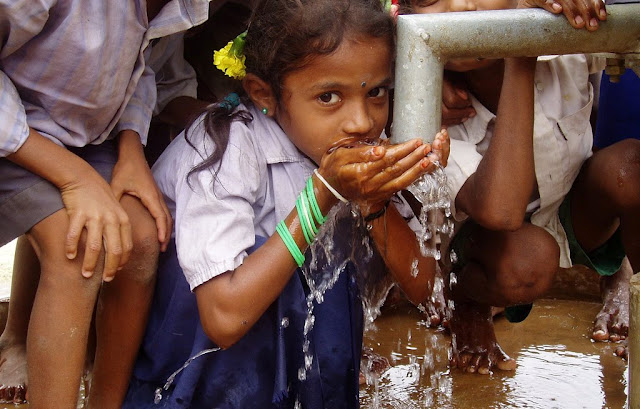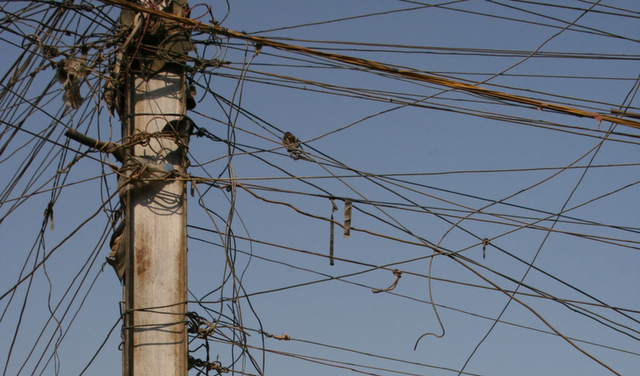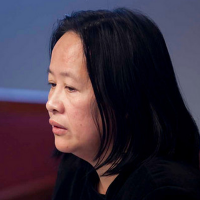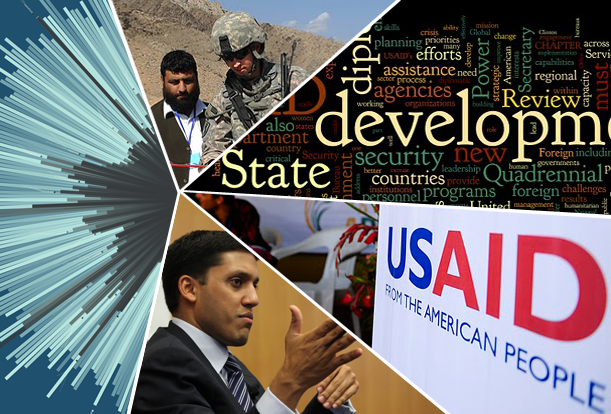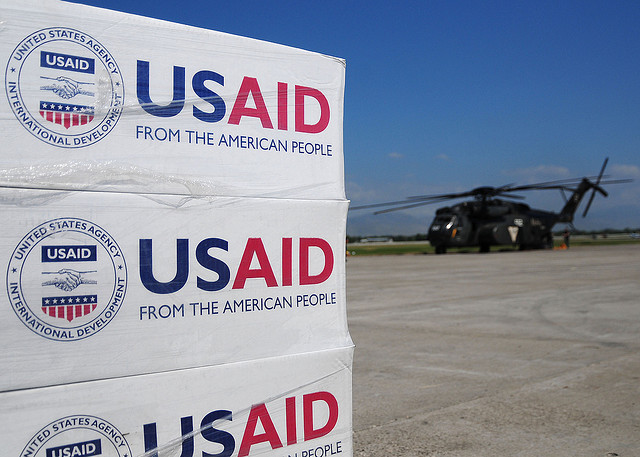Showing posts from category global health.
-
Congressional Hearing: Clean Water Access Is a Global Crisis, Human Right, and National Security Issue
›March 17, 2011 // By Hannah MarquseeUnsafe drinking water causes nearly 1.8 million deaths each year from diarrhea, “a number that dwarfs the casualties associated with violent conflict,” said U.S. Representative James McGovern at a congressional human rights commission hearing earlier this month on water as a basic right. Nearly all of these deaths are children under the age of five, he said. “This is a war against families, children, and women on an ongoing basis,” said Representative Earl Blumenauer, also speaking at the hearing, titled “Realizing the Right to Safe Water and Sanitation.”
There are currently 884 million people in the world without access to safe drinking water, according to UNICEF, and 2.6 billion without improved sanitation. As population growth and climate change place added stress on fresh-water systems, by 2025, two thirds of the world’s population will live in water-stressed conditions, according to the Food and Agriculture Organization. “This is a severe global crisis,” said McGovern.
“A Human Right”
With 2011 World Water Day only weeks away, the hearing harkened back to Secretary Clinton’s widely quoted statement from World Water Day 2010, marking a commitment by the Obama administration to address global water issues:It’s not every day you find an issue where effective diplomacy and development will allow you to save millions of lives, feed the hungry, empower women, advance our national security interests, protect the environment, and demonstrate to billions of people that the United States cares. Water is that issue.
Four months after that statement, the UN passed a resolution to make access to water and sanitation a human right, not just a development priority. Said Catarina de Albuquerque, a UN independent expert who testified at this month’s congressional hearing, the resolution stipulates that water must be “available, accessible, affordable, acceptable and safe.” A “right to water” is an important “sign of political will,” that will place increased obligations on governments to improve access to water and sanitation, she said. But in the meantime, for the millions without access to safe water, “there is no change.”
According to the UN, the world is on track to meet the Millennium Development Goal target of halving the number of people without access to an improved water source by 2015. But de Albuquerque noted that the reality is not quite so optimistic. On a UN fact-finding mission, she encountered at least one family who by UN definitions had access to an “improved drinking water source,” yet their tap water was literally black. “Water quality is not being monitored” and for many of the people who do have access, it is simply “undrinkable,” she said.
In developed countries as well, there are significant barriers to access, especially for marginalized communities. On a recent mission to the United States, de Albuquerque found that America’s “voiceless” – people of color, Native Americans, and the homeless – face significant discrimination in access to water. “Society closes its eyes to them,” she said. Thirteen percent of Native Americans lack access to safe water, in comparison to 0.6 percent of non-native Americans, she said in a statement to the press releasing her findings. And in Boston, “for every one percent increase in the city ward’s percentage of people of color, the number of threatened cut-offs increases by four percent.” To make the necessary improvements to fill these gaps in America’s aging water infrastructure would cost $4 to $6 billion annually, she said.
A National Security Issue
Water “is a security issue as well as a human development issue,” said Blumenauer. Since, according to UNEP, 40 percent of the world relies on river basins that share two or more political boundaries, water management has enormous potential for both conflict and cooperation. Echoing Clinton’s World Water Day statement, McGovern championed the cross-cutting nature of water:The right to water is inextricably linked with other basic rights…including the right to food, the right to health, and the right to education.
The burden of collecting water in underdeveloped countries often creates a gender gap and exposes women and girls to violence and rape, he said. And it “has been the basis for many territorial and violent disputes between various peoples and even nations.”
Last month, a staff report by the Senate Foreign Relations Committee expressed a similar sentiment with the publication of their report, Avoiding Water Wars: Water Scarcity and Central Asia’s Growing Importance for Stability in Afghanistan and Pakistan. The report commends the Obama administration for recognizing the importance of water: “For the first time, senior government officials are recognizing the critical role that sound water management must play in achieving our foreign policy goals and in protecting our national security.” However, by exclusively focusing on Pakistan and Afghanistan’s water issues and “neglecting the interconnectivity of water issues between Central and South Asia, the U.S. approach could exacerbate regional tensions,” the report says.
To be more strategic about water assistance, the report recommends the United States: (1) provide technical support in data collection to better manage water; (2) help increase water efficiency and reduce demand for water; (3) recognize the transboundary nature of water issues and “provide holistic solutions;” and (4) “safeguard institutions against shocks to water supply and demand.”
Moving Forward
The Obama administration’s commitment to water issues, the UN’s recognition of water as a human right, and the 2005 Water for the Poor Act have all been important steps towards fulfilling the pledge of making access to safe water a human right. “We’ve come a long way,” Blumenauer (who authored the Water for the Poor Act) said at the hearing, but there is still significant work ahead.
“We’re going to have to be more strategic moving forward” in order to meet global water shortages, said Aaron Salzberg, special coordinator for water resources for the U.S. Department of State who testified at the hearing. Salzberg recommended that the U.S. government take steps to integrate water management with the food and health sectors; build political will; mobilize financial support; promote science and technology; and form partnerships with other governments and aid organizations. The United States must also “be smarter” about allocating funds based on the dual criteria of “need” and “opportunity.” Balancing efforts with partners to find out which countries have the greatest need and the least resources will allow limited U.S. funds to make the deepest impact, he said.
John Oldfield, managing director of the WASH Advocacy Initiative, urged Congress to increase funding for foreign assistance, continue appropriations for the Water for the Poor Act, and improve the effectiveness of existing water, sanitation, and hygiene (WASH) assistance. “Each dollar invested in water and sanitation leads to an 8:1 return from reduced healthcare costs and time savings,” he said. “The world does not need to bury millions more of its children in the coming years when we know how to prevent waterborne disease today.”
Sources: FAO, UNEP, UNICEF, United Nations, WHO.
Image Credit: Adapted from “School girl drinks water from new handpump,” courtesy of flickr user waterdotorg. -
Watch: Roger-Mark De Souza on the Scaling Advantages of Population, Health, and Environment Integration
›March 11, 2011 // By Schuyler NullBy integrating population, health, and environment (PHE) efforts, development programs can make a difference in people’s lives in a real and meaningful way – one which they understand, appreciate, and desire, said Roger-Mark De Souza in this interview with ECSP. De Souza is the vice president of research and director of the Climate Program at Population Action International.
The PHE approach “allows itself to be applied at different levels,” said De Souza. “It’s easily implemented at the level of a village, or a town, or a city where a number of individuals can say ‘these are concrete results and outcomes that we want in our lives and that we want to live our lives in an integrated way.’”
PHE interventions not only provide tangible results to individuals, said De Souza, but they also help accomplish broader policy objectives, including improving health and alleviating poverty.
“There are lessons to be learned from different areas of integration, not just population, health, and environment,” De Souza said. For example, initiatives that integrate food security and HIV/AIDS deal with issues “similar to the ones we deal with in integrating population, health, and environment,” he said. Lessons and experiences need to be shared between these communities, but they also share similar advantages: From a cost-efficiency stand point, integration simply provides greater “bang for the buck,” he said. -
Celebrating Ordinary Women Doing Extraordinary Things to Improve Gender Equality and Maternal Health Worldwide
›As coordinator of one of the few forums dedicated solely to maternal and reproductive health in Washington, D.C., I am particularly excited about this year’s 100th anniversary of International Women’s Day. This day commemorates ordinary women doing extraordinary things and acknowledges both the progress made and barriers still faced by women worldwide.
“When it comes to the boardroom meetings, government sessions, peace negotiations, and other assemblies where crucial decisions are made in the world, women are too often absent,” said Secretary of State Hillary Clinton during her remarks for International Women’s Day. “It is clear that more work needs to be done to consolidate our gains and to keep momentum moving forward.” [Video Below]
For mothers worldwide, some momentum has indeed been gained: Maternal mortality rates dropped from 526,000 a year in 1980 to 342,900 in 2008, according to a report by the Institute of Health Metrics and Evaluation at the University of Washington. In September of last year, a group of international leaders – including the UN and other multilateral institutions, donors, the business community, and NGOs – launched the “Global Strategy for Women and Children’s Health” and committed $40 billion to save the lives of 16 million women and children in developing countries.
At the sixth meeting of the Wilson Center’s Advancing Policy Dialogue on Maternal Health Series, Mayra Buvinic, sector director of the World Bank’s gender and development group, said: “Investing in women and girls is the right thing to do. It is not only fair for gender equality, but it is smart economics.” She said the World Bank has found that empowering women allows families to better endure economic crises and leads to better futures for their children as well.“When women have better education and health, mothers have greater household decision-making power and prioritize the well-being of their children,” said Buvinic. “In return, children have better educational attainment and are productive adults, building long-term economic growth.”
However, increased investment will only pay off when money is translated into action and stakeholders are held accountable for empowering women.
Since the inauguration of International Women’s Day 100 years ago, the low status of women in many parts of the world has remained relatively unchanged. Many women are still subject to male-dominated values that preclude them from making basic decisions about “who to marry, when to marry, when to have children, and how many children to have,” said Nafis Sadik, special envoy of the UN Secretary-General for HIV/AIDS, in an interview with the Population Reference Bureau. To change this, international development strategies need to prioritize improving gender equality, women’s status, and women’s voice in the political process.
I am grateful to be working in collaboration with extraordinary institutions such as the Maternal Health Task Force (MHTF) and United Nations Population Fund (UNFPA) who take real steps every day to help improve the lives of women and girls. In collaboration with these institutions, the Wilson Center’s Global Health Initiative is please to announce that it will partner with the African Population Health Research Center in Kenya to co-host a three-part dialogue series with local, regional, and national decision-makers on effective maternal health policies and programs. These in-country dialogue meetings will create a platform for field workers, policymakers, program managers, media, and donors to share research, disseminate lessons learned, and address concerns related to policy, institutional, and organizational capacity building for improved maternal health outcomes.
It is our goal that programs like these will continue to highlight neglected maternal health and issues and galvanize the community everyday – and not just on International Women’s Day.
Sources: Population Reference Bureau, UN, UN Population Fund, U.S. State Department.
Photo Credit: Afghan girl, courtesy of flickr user U.S Embassy Kabul Afghanistan, and Secretary Clinton’s video address courtesy of the U.S. State Department. -
What’s Behind Iraq’s Day of Rage? It’s Pretty Basic
›March 4, 2011 // By Schuyler NullIraq’s “Day of Rage” – a phenomenon that has swept the Middle East since Tunisia’s “Jasmine Revolution” – reportedly claimed the lives of nearly 20 people last week. But though the protests may have been inspired by the current broader movement in the region, they are also a symptom of long-standing grievances ordinary Iraqis have had with their government since the American invasion, including lack of public services like access to clean water and especially, reliable electricity.
While these protests alone are unlikely to lead to revolution, they reveal basic livelihood challenges that neither the United States nor the Maliki government have effectively addressed.
The protests in Baghdad and more than 10 other cities were the largest since last summer, when demonstrations over access to electricity led to the death of two protestors in Basra. The New Security Beat spoke to Iraq’s first Minister of the Environment, Mishkat Al Moumin, after those protests to ask her about the lack of services and Iraq’s other non-security challenges, including water security, women’s empowerment, and demographics. She said that decentralizing decision-making power might help alleviate pressure on the government and provide more effective local services:Enacting policies at the local level establishes a sense of ownership among local communities and provides them with an incentive to protect their environmental resources. Moreover, it provides a better opportunity to involve the main stakeholders in policymaking.
Frederick Burkle, senior public policy scholar at the Wilson Center and a senior fellow of the Harvard Humanitarian Initiative at the Harvard School of Public Health, recently cited the military’s failure to restore services, specifically public health services in Iraq, as something the State Department and USAID should seize on to justify the end of “militarized aid.” He pointed out that a 2004 joint report by the Iraqi Ministry of Health and Red Cross found more death and illness was due to the country’s decimated public health infrastructure and social protections than to the violence of war:These indirect deaths from war are preventable but require attention from the occupying powers to the invaded country’s declining public health, social, and physical protections. Iraqis were well aware of this deficiency, and the United States’ lack of attention to the matter led to the loss of lasting trust.
For more on Iraq, be sure to also check out The New Security Beat’s interview with Steve Lonergan, former head of Canada-Iraq Marshlands Initiative, on the state of the southern marshes and their potential for peacemaking.
Sources: Foreign Affairs, The New York Times.
Photo Credit: Adapted from “Tangle of electrical wires in Baghdad,” courtesy of flickr user News Hour (PBS News Hour – Larisa Epatko). -
Joan Castro on Integrated Population and Coastal Resource Management in the Southern Philippines
› In the southern Philippines, the innovative IPOPCORM program “worked in areas where there is high…marine biodiversity, high population, and high population momentum, which means…about 40 percent of the population are 15 years and below,” Joan Castro told ECSP in this interview. Castro, the executive vice president of PATH Foundation Philippines, Inc., recently spoke at the Wilson Center on the state of integrated development efforts in her country and elsewhere.
In the southern Philippines, the innovative IPOPCORM program “worked in areas where there is high…marine biodiversity, high population, and high population momentum, which means…about 40 percent of the population are 15 years and below,” Joan Castro told ECSP in this interview. Castro, the executive vice president of PATH Foundation Philippines, Inc., recently spoke at the Wilson Center on the state of integrated development efforts in her country and elsewhere.
From 2000-2006, IPOPCORM (which stands for “integrated population and coastal resource management”) sought to integrate population, health, and environment (PHE) development efforts in Philippine communities. They had four primary objectives, said Castro: 1) improve the reproductive health of the community members; 2) improve management of the coastal resources; 3) increase knowledge of the linkages between population, health, and the environment; and 4) increase the capacity of community leaders to advocate for these links.
“The aspect of livelihoods was very essential,” said Castro, especially for empowering women in the communities. Through family planning services and micro-credit finance initiatives, women were able to better space their pregnancies and contribute to household incomes, she said. In addition, by establishing locally managed, marine protected areas, IPOPCORM increased the protection of high biodiversity zones and improved the likelihood that there will be enough fish to feed future generations.
The “Pop Audio” series is also available as podcasts on iTunes. -
QDDR Coverage Wrap-up: Institutional Shifts, Development-as-Security, Women’s Empowerment, and Complex New Threats
›February 23, 2011 // By Schuyler NullSomewhat lost in the wake of turmoil in the Middle East and the budget battle in Congress has been the State Department’s most aggressive attempt yet to reshape itself for the dynamic foreign policy challenges of the 21st century.
-
USAID’s Role in National Security: Development Matters and It’s Cheaper Than You Think
›February 22, 2011 // By Ramona Godbole“Development is not and cannot be a sideshow,” said U.S. Agency for International Development (USAID) head Rajiv Shah, in a speech at the Center for Global Development on January 19. This year marks the 50th anniversary of USAID, and there are some promising changes in the works for the agency as it transforms itself into a “modern development enterprise.”
Over the past year, the Obama administration launched the Quadrennial Diplomacy and Development Review (the QDDR – see our full set of reviews on this first-of-its-kind document), Feed the Future, and the Global Health Initiative. In accordance with these new strategic initiatives, USAID has launched USAID Forward to implement a series of reforms to strengthen its capacity to meet the world’s development challenges effectively and efficiently. The agency has tried to foster a “spirit of innovation, science, technology, and smarter strategic thinking to each of [its] areas of core focus: gender, education, water, and climate,” said Shah. In his speech at CGD, he announced a new, re-worked evaluation policy and outlined a number of cost-saving actions, including graduating countries that no longer need aid, promoting procurement and contracting reform, and eliminating some costly senior positions in the agency.
Value to Shareholders
Moving forward, USAID is working to further reduce inefficiencies and increase transparency, said Shah, and is “focused on delivering the highest possible value for our shareholders – the American people and the congressional leaders who represent them.” He added that “like an enterprise, we’re relentlessly focused on delivering results and learning from success and failure.”
These are exciting changes for the development community. But, if Congress significantly cuts funding, by, for example, passing a plan similar to one endorsed by 165 Republican representatives a few weeks ago, these changes might not see the light of day – the plan proposed to save $1.39 billion by eliminating agency operating expenses. Putting that in perspective, the USAID operating budget for the past fiscal year was $1.69 billion. (Strangely, while the plan all but eliminates the agency that administers them, it does little to cut actual outgoing foreign assistance monies.)
The plan, however, may reflect the views of much of the American public. A World Public Opinion poll showed that Americans believe the government spends up to 25 percent of its budget on foreign aid and want to cut back to 10 percent, while in fact, aid represents just one percent of the federal budget (compared with more than 20 percent for defense).
What the proposed plan fails to take into account is development’s role in promoting peace, security, and prosperity globally. Said Shah at CGD, “as the President and the Secretaries of State, Treasury, and Defense have all made abundantly clear, development is as critical to our economic prospects and our national security as diplomacy and defense.”
A More Efficient Investment
Shah elaborated on this idea in an interview with Foreign Policy last month: “In the military they call us a high-value, low-density partner because we are of high value to the national security mission but there aren’t enough of us and we don’t have enough capability,” he said. “This is actually a much, much, much more efficient investment than sending in our troops, not even counting the tremendous risk to American lives when we have to do that.”
Chad Briggs, a professor for the USAF Air University, pointed out the multiple benefits to the military that increased State and USAID agency in the field could provide in his review of the QDDR:Considering the existing responsibilities of the United States overseas and the potential for future risks and crises that will need to be addressed, the QDDR’s recommendations to strengthen engagement abroad can only be a positive step for U.S. interests. If the various hurdles enumerated above and elsewhere can be addressed, the QDDR’s focus on emerging risks may also ease the burden on DOD resources and force deployments, recognizing that not every engagement abroad should be resolved by the military alone.
If done right, development can provide both economic growth and democratic governance and help stabilize countries before, during, and after conflict or crisis in a cost-effective way while simultaneously addressing transnational human and environmental security issues like hunger, poverty, disease, and climate change (see Yemen for an example where the application of soft power now could reduce the chance of deploying more hard power later).
Policymakers should support USAID’s current efforts to make smarter investments, “which over time will save hundreds of millions of dollars, as opposed to trying to save a little bit now by cutting our capacity to do oversight and monitoring,” said Shah in Foreign Policy.
Sources: Center for Global Development, The Economist, Foreign Policy, USAID, U.S. Department of State, World Public Opinion.
Photo Credit: “Pallets of food, water and supplies staged to be delivered,” courtesy of flickr user USAID_Images. -
Health, Demographics, and the Environment in Southeast Asia
›“Health and Health-Care Systems in Southeast Asia: Diversity and Transitions,” launches a series in The Lancet on health in Southeast Asia. While social, political, and economic development have paved the way for substantial health improvements in some countries, demographic transitions are taking place at among the fastest rates in the world, including reductions in fertility, population aging, and rural-to-urban migration. An epidemiological shift is occurring as well, from infectious to chronic diseases. Rapid urbanization and population movement can not only affect the emergence and spread of new infectious diseases directly, but can also exacerbate environmental changes that indirectly contribute to the burden of waterborne and vector-borne diseases. The series, available early online, addresses these concerns in more detail. Moving forward, the authors advocate for “enhanced regional cooperation in the health sector to share knowledge and rationalize health systems operations, leading to further public health gains for the region’s diverse populations.”
In “A Stormy Future for Population Health in Southeast Asia,” author Colin D. Butler responds to the series, stressing that the health of the future generation is dependent on actions today. Environmental change will likely bring sea-level rise that threatens urban centers and food bowls, causing regional food scarcity, exacerbating diseases like dengue fever, increasing the number of extreme weather events, and contributing to resource scarcity throughout the region. With increasing need for sustainable development in the region, Butler concludes that “stronger human factors will be essential to counter the increased physical stresses that seem to be the inevitable destiny of Southeast Asia, largely as a result of the actions of people who have never seen its shores.”


